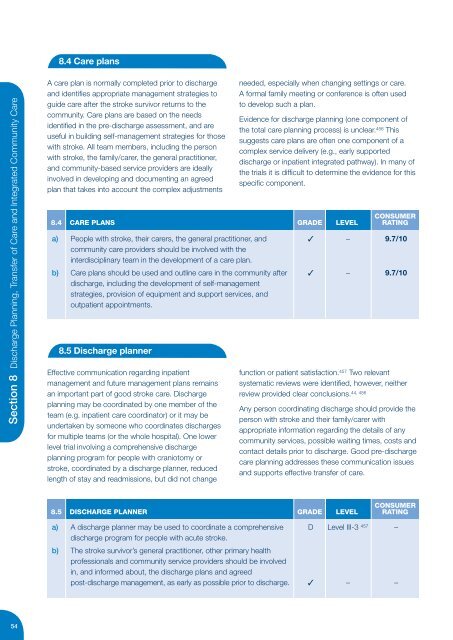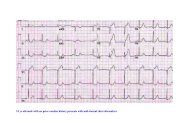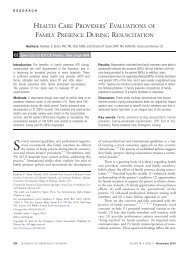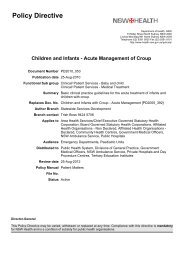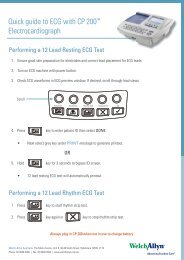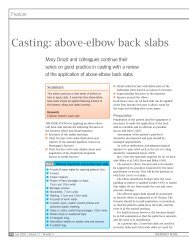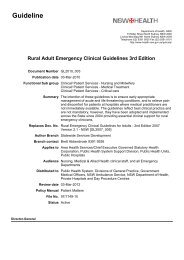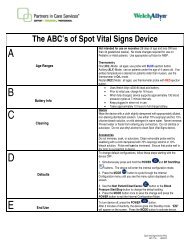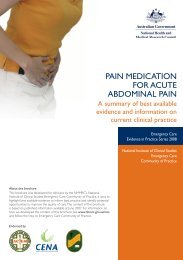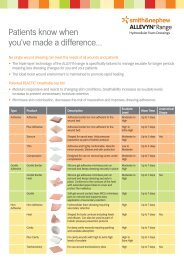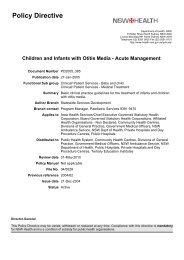Clinical Guidelines for Acute Stroke Management - Living on the EDge
Clinical Guidelines for Acute Stroke Management - Living on the EDge
Clinical Guidelines for Acute Stroke Management - Living on the EDge
You also want an ePaper? Increase the reach of your titles
YUMPU automatically turns print PDFs into web optimized ePapers that Google loves.
8.4 Care plans<br />
Secti<strong>on</strong> 8 Discharge Planning, Transfer of Care and Integrated Community Care<br />
A care plan is normally completed prior to discharge<br />
and identifies appropriate management strategies to<br />
guide care after <strong>the</strong> stroke survivor returns to <strong>the</strong><br />
community. Care plans are based <strong>on</strong> <strong>the</strong> needs<br />
identified in <strong>the</strong> pre-discharge assessment, and are<br />
useful in building self-management strategies <str<strong>on</strong>g>for</str<strong>on</strong>g> those<br />
with stroke. All team members, including <strong>the</strong> pers<strong>on</strong><br />
with stroke, <strong>the</strong> family/carer, <strong>the</strong> general practiti<strong>on</strong>er,<br />
and community-based service providers are ideally<br />
involved in developing and documenting an agreed<br />
plan that takes into account <strong>the</strong> complex adjustments<br />
needed, especially when changing settings or care.<br />
A <str<strong>on</strong>g>for</str<strong>on</strong>g>mal family meeting or c<strong>on</strong>ference is often used<br />
to develop such a plan.<br />
Evidence <str<strong>on</strong>g>for</str<strong>on</strong>g> discharge planning (<strong>on</strong>e comp<strong>on</strong>ent of<br />
<strong>the</strong> total care planning process) is unclear. 456 This<br />
suggests care plans are often <strong>on</strong>e comp<strong>on</strong>ent of a<br />
complex service delivery (e.g., early supported<br />
discharge or inpatient integrated pathway). In many of<br />
<strong>the</strong> trials it is difficult to determine <strong>the</strong> evidence <str<strong>on</strong>g>for</str<strong>on</strong>g> this<br />
specific comp<strong>on</strong>ent.<br />
CONSUMER<br />
8.4 CARE PLANS GRADE LEVEL RATING<br />
a) People with stroke, <strong>the</strong>ir carers, <strong>the</strong> general practiti<strong>on</strong>er, and ✓ – 9.7/10<br />
community care providers should be involved with <strong>the</strong><br />
interdisciplinary team in <strong>the</strong> development of a care plan.<br />
b) Care plans should be used and outline care in <strong>the</strong> community after ✓ – 9.7/10<br />
discharge, including <strong>the</strong> development of self-management<br />
strategies, provisi<strong>on</strong> of equipment and support services, and<br />
outpatient appointments.<br />
8.5 Discharge planner<br />
Effective communicati<strong>on</strong> regarding inpatient<br />
management and future management plans remains<br />
an important part of good stroke care. Discharge<br />
planning may be coordinated by <strong>on</strong>e member of <strong>the</strong><br />
team (e.g. inpatient care coordinator) or it may be<br />
undertaken by some<strong>on</strong>e who coordinates discharges<br />
<str<strong>on</strong>g>for</str<strong>on</strong>g> multiple teams (or <strong>the</strong> whole hospital). One lower<br />
level trial involving a comprehensive discharge<br />
planning program <str<strong>on</strong>g>for</str<strong>on</strong>g> people with craniotomy or<br />
stroke, coordinated by a discharge planner, reduced<br />
length of stay and readmissi<strong>on</strong>s, but did not change<br />
functi<strong>on</strong> or patient satisfacti<strong>on</strong>. 457 Two relevant<br />
systematic reviews were identified, however, nei<strong>the</strong>r<br />
review provided clear c<strong>on</strong>clusi<strong>on</strong>s.<br />
44, 456<br />
Any pers<strong>on</strong> coordinating discharge should provide <strong>the</strong><br />
pers<strong>on</strong> with stroke and <strong>the</strong>ir family/carer with<br />
appropriate in<str<strong>on</strong>g>for</str<strong>on</strong>g>mati<strong>on</strong> regarding <strong>the</strong> details of any<br />
community services, possible waiting times, costs and<br />
c<strong>on</strong>tact details prior to discharge. Good pre-discharge<br />
care planning addresses <strong>the</strong>se communicati<strong>on</strong> issues<br />
and supports effective transfer of care.<br />
CONSUMER<br />
8.5 DISCHARGE PLANNER GRADE LEVEL RATING<br />
a) A discharge planner may be used to coordinate a comprehensive D Level III-3 457 –<br />
discharge program <str<strong>on</strong>g>for</str<strong>on</strong>g> people with acute stroke.<br />
b) The stroke survivor’s general practiti<strong>on</strong>er, o<strong>the</strong>r primary health<br />
professi<strong>on</strong>als and community service providers should be involved<br />
in, and in<str<strong>on</strong>g>for</str<strong>on</strong>g>med about, <strong>the</strong> discharge plans and agreed<br />
post-discharge management, as early as possible prior to discharge. ✓ – –<br />
54


